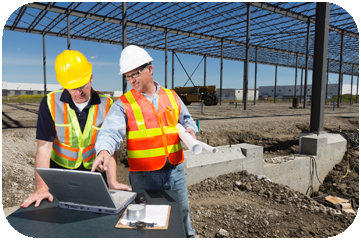Professional Civil Geotechnical Engineering Services for Complicated Projects
Wiki Article
A Comprehensive Exam of the Solutions Given by Consulting Engineers in the Field of Geotechnical Design: From Site Examination to Project Application
Consulting engineers in geotechnical engineering play a critical function in the successful execution of building jobs, beginning with detailed site investigations that disclose essential subsurface problems. Their knowledge prolongs to dirt residential or commercial property evaluations, ecological influence evaluations, and the careful monitoring of project application, ensuring alignment with safety and sustainability standards.Importance of Geotechnical Engineering
Geotechnical engineering is an essential technique that underpins the safety and security and sustainability of civil infrastructure projects. By understanding the mechanical behavior of dirt and rock products, geotechnical engineers assess the suitability of websites for numerous building and constructions, consisting of buildings, bridges, and dams. This fundamental analysis makes sure that structures can endure ecological aspects and tons without experiencing failing.The significance of geotechnical engineering extends past mere architectural safety; it additionally encompasses environmental stewardship. Appropriate geotechnical evaluations add to lessening the environmental impact of construction. Through cautious assessment of soil homes and groundwater conditions, designers can create foundations and retaining frameworks that minimize risks such as erosion and landslides, promoting lasting security.
Moreover, geotechnical design plays a vital function in project price administration. geotechnical works. By determining prospective problems early in the design phase, engineers can suggest ideal solutions, therefore staying clear of costly hold-ups and redesigns during building and construction. This positive strategy not only improves task performance but likewise significantly decreases threats related to unanticipated website conditions
Website Examination Methods
Reliable site examination techniques are important for gathering accurate data concerning subsurface conditions prior to construction. These methods facilitate the understanding of the geological and hydrological setting, which is important for making sure the security and security of proposed structures.Typical techniques utilized in site examinations include borehole boring, which enables engineers to extract soil samples at various midsts, giving understandings right into stratification and product types. Furthermore, geophysical surveys, such as seismic refraction and electrical resistivity, offer non-invasive methods to analyze subsurface features over bigger locations. These techniques can assist identify anomalies without extensive excavation.
Test pits are an additional valuable strategy, providing direct monitoring of dirt layers and enabling in-situ testing. geotechnical works. This approach is particularly helpful for superficial excavations and can aid evaluate groundwater levels. Moreover, cone penetration tests (CPT) are significantly utilized, as they supply continuous accounts of dirt resistance, which aids in figuring out dirt strength and layering.
Each of these strategies plays a crucial function in establishing a thorough understanding of website conditions, allowing consulting engineers to make informed decisions and referrals throughout the project lifecycle. Accurate information collection during the site investigation phase is critical to mitigating risks and making sure effective job application.
Soil Home Assessment

The evaluation procedure commonly includes a mix of lab tests and area investigations. Secret residential or commercial properties such as shear toughness, compressibility, permeability, and moisture content are examined to establish the dirt's viability for construction functions. Typical tests, including the Atterberg limitations, Proctor compaction, and triaxial shear examinations, are frequently employed to gather data on soil behavior.
Along with these tests, in-situ techniques such as the Standard Infiltration Test (SPT) and Cone Penetration Examination (CPT) provide beneficial insights into dirt stratigraphy and thickness. The outcomes of these assessments inform designers about prospective challenges, such as dirt liquefaction or negotiation, enabling them to develop appropriate reduction methods.
Environmental Effect Assessment
Ecological effect assessment plays a vital function in the planning and implementation of engineering projects, specifically in geotechnical engineering. This procedure includes evaluating the potential ecological consequences of suggested jobs on soil, water, air top quality, and surrounding ecosystems. Consulting designers use various methodologies, consisting of site analyses, modeling, and field studies, to recognize and quantify these impacts.The analysis commonly starts with the identification of standard environmental problems, which acts as a reference for forecasting possible adjustments. Engineers assess factors such as erosion, groundwater contamination, and environment disturbance, guaranteeing that all relevant environmental laws and standards are adhered to throughout the job lifecycle. Stakeholder engagement is additionally an important part of the evaluation procedure, as it cultivates communication in between job developers, neighborhood neighborhoods, and governing bodies.
Additionally, reduction techniques are created to deal with recognized impacts, enabling designers to suggest options or modifications to predict designs that improve sustainability. This positive technique not just reduces adverse results on the setting however additionally promotes public depend on and consulting civil engineering companies compliance with environmental regulations. Ultimately, effective ecological effect assessment reinforces the overall stability and feasibility of geotechnical design jobs, supporting liable growth practices.
Job Implementation and Monitoring

Monitoring is a crucial element of project application. Designers use different methods, such as instrumentation and field tests, to evaluate soil habits and structural feedbacks in real-time. This continuous tracking makes it possible for the identification of any type of deviations from expected efficiency, permitting for timely interventions to minimize risks.
Moreover, speaking with engineers maintain open interaction with service providers and stakeholders throughout the process. Routine site inspections and report card make sure that all celebrations are educated regarding project condition and any kind of arising concerns. By fostering collaboration and transparency, getting in touch with designers facilitate a more efficient implementation process, thus improving job end results.
Inevitably, reliable task execution and surveillance not just copyright safety and high quality requirements however likewise contribute to the general success of geotechnical jobs, ensuring they fulfill their desired objectives sustainably and sensibly.

Conclusion
Finally, the duty of seeking advice from engineers in geotechnical engineering encompasses a critical series of solutions that make certain job success. From extensive site examinations to extensive soil building evaluations and ecological impact analyses, these specialists prepared for secure and sustainable building practices. Constant surveillance throughout job implementation better guarantees architectural stability and stakeholder communication. Ultimately, the complex payments of consulting designers are important in resolving the complexities of geotechnical challenges in modern-day engineering tasks.Report this wiki page